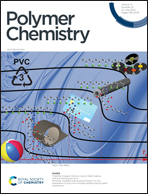Fused carbazole–coumarin–ketone dyes: high performance and photobleachable photoinitiators in free radical photopolymerization for deep photocuring under visible LED light irradiation†
Abstract
In this work, three dyes based on fused carbazole–coumarin–ketone structures were designed and synthesized. These dyes were named CCK–Me, CCK–Ph, and CCK–Tol in accordance with their different substituents. Their excellent absorption properties can match the wavelength band of visible light-emitting diodes (LEDs) (i.e., 405–450 nm). Density functional theory calculations, steady-state photolysis, and electron spinning resonance spin trapping experiments were performed to explain the photophysical and photochemical mechanisms of the dyes. These dyes are available as one- or two-component type II photoinitiators (PIs). Both kinds can efficiently initiate the polymerization of acrylate monomers via two different mechanisms under 405–450 nm LED irradiation. Notably, CCK–Tol exhibited excellent photobleaching ability when initiated alone, making it ideal for deep curing. The polymeric samples were up to 57 mm thick. Remarkably, the photolysis product of CCK–Tol showed satisfactorily low cytotoxicity. The above excellent properties showed the great potential application of the dyes in various photocuring materials, especially dental materials and thick three-dimensional structures.



 Please wait while we load your content...
Please wait while we load your content...